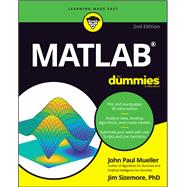Go from total MATLAB newbie to plotting graphs and solving equations in a flash!
MATLAB is one of the most powerful and commonly used tools in the STEM field. But did you know it doesn’t take an advanced degree or a ton of computer experience to learn it? MATLAB For Dummies is the roadmap you’ve been looking for to simplify and explain this feature-filled tool.
This handy reference walks you through every step of the way as you learn the MATLAB language and environment inside-and-out. Starting with straightforward basics before moving on to more advanced material like Live Functions and Live Scripts, this easy-to-read guide shows you how to make your way around MATLAB with screenshots and newly updated procedures. It includes:
- A comprehensive introduction to installing MATLAB, using its interface, and creating and saving your first file
- Fully updated to include the 2020 and 2021 updates to MATLAB, with all-new screenshots and up-to-date procedures
- Enhanced debugging procedures and use of the Symbolic Math Toolbox
- Brand new instruction on working with Live Scripts and Live Functions, designing classes, creating apps, and building projects
- Intuitive walkthroughs for MATLAB’s advanced features, including importing and exporting data and publishing your work
Perfect for STEM students and new professionals ready to master one of the most powerful tools in the fields of engineering, mathematics, and computing, MATLAB For Dummies is the simplest way to go from complete newbie to power user faster than you would have thought possible.









